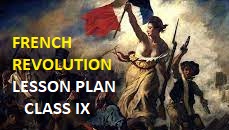French Revolution Lesson Plan With Activities For Class IX
French Revolution Lesson Plan With Activities For Class IX provides a clear outline of the learning objectives, instructional strategies, and assessment methods for a particular lesson. It is a vital tool for teachers, especially when teaching complex topics like the French Revolution. This French Revolution lesson plan will help the teacher to structure the lesson in a way that is engaging and informative for the students. The teacher can use the lesson plan to introduce the topic, provide background information, and identify the key events, ideas, and people associated with the Revolution.
Furthermore, a lesson plan on the French Revolution will also help the teacher to organize the resources and materials needed for the lesson. It will also help in identifying the challenges and to plan for different learning styles and abilities among the students. Teachers can also make use of Edu-puzzles and Gamification to make their class live and interesting.
French Revolution Lesson Plan With Activities For Class IX
Class IX
Chapter 1
Topic: French Revolution
No. of periods required: 8-10
General Objective:
To develop interest in the subject.
To develop the spirit of Nationalism among the students.
Specific Objective:
The main objective of teaching the French Revolution to students is to help them develop a broader and more nuanced understanding of history, society,
and culture, as they engage with one of the most transformative periods in human history.
The main objective of teaching the French Revolution to students is to
- help them understand the significant political, social, and cultural changes that occurred during this period in French history.
- spread of democratic ideas, the rise of nationalism, and the development of modern ideologies.
- to develop critical thinking skills and historical awareness,
- To learn about the causes and consequences of political revolutions, as well as the
- challenges and opportunities associated with social change.
Learning Objective:
The learning objectives of teaching the French Revolution may vary depending on the level of the students, the curriculum, and the goals of the course.
However, here are a few possible learning objectives that are included in a lesson plan:
Understand the historical context
Firstly, students should be able to explain the political, social, and economic conditions that led to the French Revolution.
including the role of the Enlightenment and the impact of the American Revolution.
Analyze the causes and consequences
Secondly students should be able to identify and analyze the key causes and consequences of the French Revolution.
including the role of the bourgeoisie, the grievances of the lower classes, and the impact of the Reign of Terror.
Identify the major events and figures
Thirdly, students should be able to identify and describe the major events and figures of the French Revolution,
including the Estates General, the Tennis Court Oath, the Storming of the Bastille, and the leadership of Robespierre and Napoleon.
Understand the impact of the French Revolution
Fourthly, students should be able to explain the lasting impact of the French Revolution on French society and politics.
This includes its influence on global history and the spread of democratic ideals.
Develop critical thinking skills:
Finally, students should be able to analyze primary sources.
identify bias and perspective, and evaluate different interpretations of the French Revolution.
French Revolution Lesson Plan With Activities For Class IX

Teaching Methodology
The teacher will use several ways to introduce the French Revolution to students, depending on their age, level of knowledge, and interests.
Start with a hook:
On the very first day, the teacher begin the lesson with a thought-provoking question, image, or quote that captures the essence of the French Revolution.
For example, the teacher will show a picture of the storming of the Bastille or ask students to reflect on the meaning of “Liberty, Equality, Fraternity.”
Provide historical context:
The teacher on the second day deals with the historical context of the French Revolution.
Provides background information on the political, economic, and social conditions of France in the late 18th century.
This will include discussing the absolute monarchy, the feudal system, and the Enlightenment ideas that inspired the revolution.
Using primary sources:
On the third day, the teacher will engage students with primary sources such as letters, diaries, and newspapers from the period.
Further, he/she will use excerpts from famous speeches like Robespierre’s “The Republic of Virtue” .
or have students read eyewitness accounts of the storming of the Bastille.
Focus on key events:
On the fourth day, the teacher highlights the key events and turning points of the French Revolution
For example, the Estates General, the Tennis Court Oath, the Reign of Terror, and the rise of Napoleon.
Teacher also use maps, diagrams, and timelines to help students visualize the sequence of events and understand their significance.
Connect to the present:
Finally, the teacher help students see the relevance of the French Revolution to their own lives by connecting it to contemporary issues.
For example, democracy, social justice, and human rights.
Also discusses how the principles of the French Revolution continue to shape politics and society around the world today.
By using a combination of these approaches, the teacher introduces the French Revolution to students in a way that is engaging, informative, and
thought-provoking.
CLASSWORK:
While planning classwork for teaching the French Revolution, the teacher considers the learning objectives and the needs of the students.
Group discussions
The teacher organizes a small-group discussion where students can explore the causes and consequences of the French Revolution.
Also assign specific topics or questions to each group.
Provide them with primary sources, such as letters or speeches, to analyze and discuss.
Role-playing activities:
The teacher plans to assign different roles to the students.
For example, Member of the Estates General, a peasant, or a revolutionary leader.
Students have to act out key events or debates from the French Revolution.
This will help students understand the perspectives of different groups and the complex nature of political and social change.
Gamification In Social Science: From Boredom to Brilliance
Analyzing artwork
The teacher brings paintings, sculptures, and other artworks from the period to help students understand the cultural and artistic aspects of the French
Revolution.
Have students analyze the artwork and discuss how it reflects the ideas and values of the period.
Writing assignments
Teacher here assign writing assignments such as essays, letters, or journals.
This will enable students to reflect on the historical events and the significance of the French Revolution.
Also Provide students with writing prompts or questions that encourage critical thinking and analysis.
A worksheet on French Revolution will be distributed to the students.
Multimedia presentations
Here, the teacher ask students to create multimedia presentations, such as videos or podcasts.
This will explore different aspects of the French Revolution.
It will be funny and creative way for students to demonstrate their knowledge and engage with the material.
Overall, The teacher plans the classwork in such a way that fulfills the needs of all type of students.
All students are engaged and actively participate.
This help students deepen their understanding of the French Revolution, engage with the material in meaningful ways, and develop critical thinking skills.
Gamification In Social Science: From Boredom to Brilliance
French Revolution Lesson Plan With Activities For Class IX
Activities Planned:
Here the teacher plans two possible classroom activities to engage students while teaching the French Revolution chapter.
1. Debate
The teacher organize a debate on a controversial topic related to the French Revolution.
Topic: use of violence during the Reign of Terror
Procedure:
- Assign students to teams.
- provide them with research materials.
- allow them prepare arguments and counter-arguments.
This activity will help students develop their critical thinking, research, and communication skills.
Moreover, it will also improve their understanding of different perspectives and points of view.
How to calculate time using longitudes explained Step by step
2. Timeline Activity
In this activity, the teacher create a timeline of the key events of the French Revolution.
Procedure:
- have students work in pairs or small groups.
- they have to identify and analyze the significance of each event.
- Teacher will provide them with primary sources, such as speeches or letters, to help them understand the context and perspective of the time.
- Then, ask them to present their findings to the class.
- Discuss the overall impact of the French Revolution on French society and global history.
This activity can help students develop their historical thinking, research, and presentation skills.
Moreover, it will also enhance their ability to analyze complex events and their impact over time.
If US Can Have Six, Why Can’t India Have Two-Time Zones?
Homework:
- The teacher asks the students to watch a Movie based on French Revolution “La Révolution francaise“
- Provides a Worksheet on French Revolution with multiple questions.
French Revolution Lesson Plan With Activities For Class IX
Interdisciplinary Linkages
The teacher integrates French Revolution with other subjects to provide a more comprehensive and interdisciplinary learning experience for students.
Literature
Teacher here assign readings of French literature from the time period, such as Victor Hugo’s Les Misérables.
Art
By using paintings, sculptures, and other artworks from the period will help students understand the cultural and artistic aspects of the French Revolution.
Social Studies
The teacher links it to various social studies topics, such as the Enlightenment, world history, or comparative government.
Science
The French Revolution will also be linked to scientific concepts, such as the development of the scientific method or the role of science in the Enlightenment.
Gamification In Social Science: From Boredom to Brilliance
Learning Outcome
After teaching the French Revolution, students can achieve various learning outcomes, depending on the focus of the course and the level of the students. Here are four possible learning outcomes:
- Students should be able to demonstrate a comprehensive understanding of the French Revolution. This includes its causes, key events, major figures, and consequences.
- They will be able to analyze and interpret primary sources related to the period.
- Students should be able to conduct independent research on the French Revolution, including identifying and evaluating sources, synthesizing information, and presenting findings in clear and compelling writing.
- Moreover, they will be able to identify the role of citizens in shaping political and social change, and demonstrate a commitment to civic engagement and social responsibility.
Remedial Measures
Personalized Instruction
Slow learners often need personalized attention to address their specific learning needs.
The teachers will work with students one-on-one or in small groups to provide extra support and guidance.
Multi-Sensory Learning
The teachers will incorporate activities that involve movement, touch, or sound to help slow learners better process and retain information.
This will include games or incorporating music or rhythm into lessons, to build their confidence and motivation.
French Revolution Lesson Plan With Activities For Class IX
Conclusion:
In conclusion, teaching the French Revolution can be an engaging and rewarding experience for both teachers and students. The French Revolution lesson plan includes a clear and concise introduction to the key events, ideas, and figures of the period. It also has a variety of activities and assessments to help students achieve learning objectives. The lesson plan on French Revolution also integrate with other subjects to provide a more interdisciplinary and comprehensive learning experience for students. French Revolution lesson plan also engage students with the complex and transformative events of the Revolution.
Gamification In Social Science: From Boredom to Brilliance





Very useful and informative
Thanks Sharmila. Keep sharing and visiting shapingminds.in
Excellent
Thank you Meenal. I hope this post was helpful to you. Keep visiting shapingminds.in